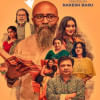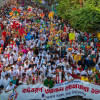Pahela Baishakh is the celebration of Bengali New Year. The name itself means First of Baishakh, the first month of the Bengali calendar. Pahela Baishakh now falls on the 14 of April of the Georgian calendar, and it is a day of joyous celebration in Bangladesh. But surely, you have wondered about its history and when or why did it all start?

The origin of Pahela Baishakh
It is believed that it was Mughal Emperor Akbar who facilitated the Bangla calendar or Bangabda.
The emperor's initiative was financial, rather than cultural.
Back in those days, agriculture was the main source of taxes, and was collected according to the Hijri calendar. The Hijri calendar, for those not in the know, is a lunar calendar, and was not in sync with crop seasons. This caused quite an issue, and the emperor took it upon himself to find a solution.
Upon his commission, Fatehullah Shirazi formulated a new calendar by aligning the Islamic calendar with the harvest season and thus, solving the issue. That's how Bangabda came into being, and we got our Pahela Baishakh as the first day of the year. The new calendar, introduced on 10 or 11 March, 1584, was initially known as Tarikh-e-Elahi.
Some debate that it was King Shashanka of Gaur (Gauda) who brought about the bangabda (Bengali calendar). However, historians lean towards Emperor Akbar as the patron for Bangla calendar.
Various celebrations
Before Pahela Baishakh became such a culturally recognised celebration, it was celebrated with the opening of new halkhata. It has survived the test of time, and still can be spotted in the shops and businesses in many areas. Once upon a time, zamindars did the same.
Festive decorations go hand in hand with halkhata in the form of confetti, flowers, and colourful designs. And of course — sweetmeats.
The Baishakhi celebration essentially kicks off with a cultural programme hosted by Chhayanaut, a cultural organisation established in 1961. Chhayanaut's first Nababarsha celebration began at the altar of the huge bot (banyan) tree, which is actually an ashwattha tree, but the place is well known by the mellifluous name — 'Ramna-r Botomul.'
There are also colourful processions, not just in Dhaka but also all across the country.
And a major part of Baishakhi celebration has to do with foods. Sweetmeats are distributed, both for opening new halkhatas, and to welcome the new year.
Red and white colours are seen in plenty, along with yellow to match the festivity. Panjabi and saree are of particular interest, and shopping prior to Pahela Baishakh has also caught on, which tells you a lot about the festivity and celebration, and how passionately people celebrate Pahela Baishakh.
As uncomfortable as an April day can be in Bangladesh, it does not put a dent in the celebration of Pahela Baishakh. Not only do people don fashionably colourful dresses, but they also go out, have fun, and enjoy a good meal with friends and family.







Comments